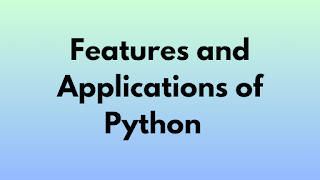Python is a flexible and widely used programming language known for its simplicity, readability, and huge libraries. It has a extensive variety of features and programs across numerous domain names. Here are a number of its key features and packages:
Features of Python:
1. Easy to Learn and Read: Python's syntax is clear and clean to recognize, making it an splendid desire for beginners and skilled programmers alike.
2. Interpreted Language: Python is an interpreted language, which means that you can write and run code immediately without the want for compilation, making improvement quicker.
3. High-Level Language: Python presents excessive-degree data sorts and dynamic typing, simplifying complex duties and lowering the period of code.
4. Extensive Standard Library: Python comes with a large standard library that gives ready-to-use modules and capabilities for various duties, from record managing to net development.
5. Cross-Platform: Python is to be had on more than one platforms (Windows, macOS, Linux), making it easy to develop cross-platform packages.
6. Open Source: Python is open-supply, which means that it is loose to use, regulate, and distribute.
7. Large Community: Python has a huge and energetic network of builders, which guarantees continuous guide, updates, and a wealth of resources.
8. Integration: Python without problems integrates with different programming languages like C, CPP, and Java, permitting you to leverage current codebases.
9. Object-Oriented: Python helps item-oriented programming, making it appropriate for organizing and dealing with complicated codebases.
10. Extensibility: You can expand Python's functionality via developing custom modules or through the usage of 1/3-party libraries and packages.
Applications of Python:
1. Web Development:
- Frameworks like Django and Flask are used to construct net packages.
- Python can be used for server-facet scripting.
2. Data Science and Machine Learning:
- Libraries like NumPy, Pandas, Matplotlib, and Scikit-Learn are popular for records analysis and device getting to know.
- Jupyter notebooks are widely used for facts exploration and evaluation.
3. Scientific Computing:
- Python is used for medical studies and simulations due to its large libraries and simplicity of use.
4. Automation and Scripting:
- Python is generally used for automating repetitive duties and writing scripts for numerous purposes.
5. Artificial Intelligence and Natural Language Processing (NLP):
- Python is a popular choice for building AI and NLP packages because of libraries like TensorFlow, Keras, and NLTK.
6. Game Development:
- Pygame is a popular library for developing 2D video games.
7. Desktop Applications:
- Libraries like PyQt and Tkinter will let you create move-platform computer applications with GUIs.
8. Network Programming:
- Python can be used for network programming and growing community-associated programs.
9. Database Management:
- Python supports diverse database systems and can be used for database control duties.
10. IoT (Internet of Things):
- Python is used in IoT projects for facts processing, device control, and information evaluation.
11. Cybersecurity:
- Python is used for responsibilities including penetration testing, community scanning, and protection evaluation.
12. Education:
- Python is commonly used as a teaching language because of its simplicity and readability.
13. Web Scraping and Data Extraction:
- Python is extensively used for internet scraping and statistics extraction from websites.
These are just a few examples of Python's capabilities and packages. Its versatility and extensive range of libraries make it a treasured tool in various fields of computer science and past.
